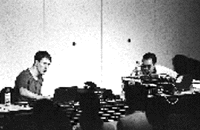
Symposium: Post-Sampling Music Theory
June 27th, 1998ICC Gallery D
Since the advent of the digital sampling machine, sampling's penetration of popular music--indeed of all types of music--has been nothing short of phenomenal. And yet this has tended to reduce all sound and music, whatever the original derivation, to the common level of "sources." We all have seen how the times have launched trends in sound quality and utilization as well as new genres of music--hip hop, house, techno--each with its own distinct "sound." It is hardly unusual that the appearance of a new instrument should lead to a new musical style, or that such music ultimately refine the special characteristics of the instrument itself. Such evolution amidst the "spin" of impinging social circumstances is surely only natural; hence all the changes in the desktop music-making environment, advancements in personal computer features, and networking technologies. Within this course of events, there are beginning to be signs of works and collaborations that go beyond the existing framework of what we know as "sampling." That is to say, sampling--or more broadly, all such digital trends--are entering what might be called the "post-sampling" phase.
The Symposium was chaired by music critic SASAKI Atsushi, who touched base with various creators: Christophe CHARLES, who produces works using MAX programming software to manipulate field recordings; HANNO Yoshihiro, who samples live (not pre-recorded) performances in order to restructure and "re-create" them; and the GNUsic project (KUBOTA Akihiro, YASAKA Kenji, SETOH Koji, who maintain an audio exchange site on the Web for accessing not only sound source files, but even the production process itself.
A clear digression was seen between HANNO, who regards sampling as a means of forging ahead into the unpredetermined process of realizing one's imagination, and CHARLES, who publishes his program data on CD, so that the creative process does not end with his "finished" work, but reaches out to others at large. Opinions were exchanged on GNUsic project's site instructions: whether they endangered "artist originality," or conversely whether they might contribute to the manifestation of potential differences. Underlying all this, of course, were the big issues of copyright and quality in the wake of the leveling of all "source" hierarchies, yet just where GNUsic's experiments will lead is still an unknown quantum, while on the other hand just how much working within their system will augment creativity also remains to be seen.
In a mini-concert during the latter half of the Symposium, CHARLES and HANNO performed a duet, each re-composing the other's "sounds = sources" that had been exchanged in advance. Sadly, unforeseen accidents plagued HANNO's sequencing software and prevented CHARLES's MAX computer screens from being projected.
But the real "mystery guest" was the frequently mentioned name Oval = Markus POPP, whose latest work <<dok>> was one of the original inspiration of the event. Totally rejecting what has become the textbook standard of "sampling," <<dok>> was created using CHARLES's works as "sources," thus exploring a way of real "post-sampling music."
Planning cooperation: SASAKI Atsushi (HEADZ)
GNUsic URL:
http://www.gnusic.net
Reference discography: Christophe CHARLES <<undirected 86-96>>, Mille Plateaux
HANNO Yoshihiro <<Portrait of A Poet>>, Flavour of Sound
Oval <<dok>>, Mille Plateaux/Thrill Jockey
[HATANAKA Minoru]

 Next
Next